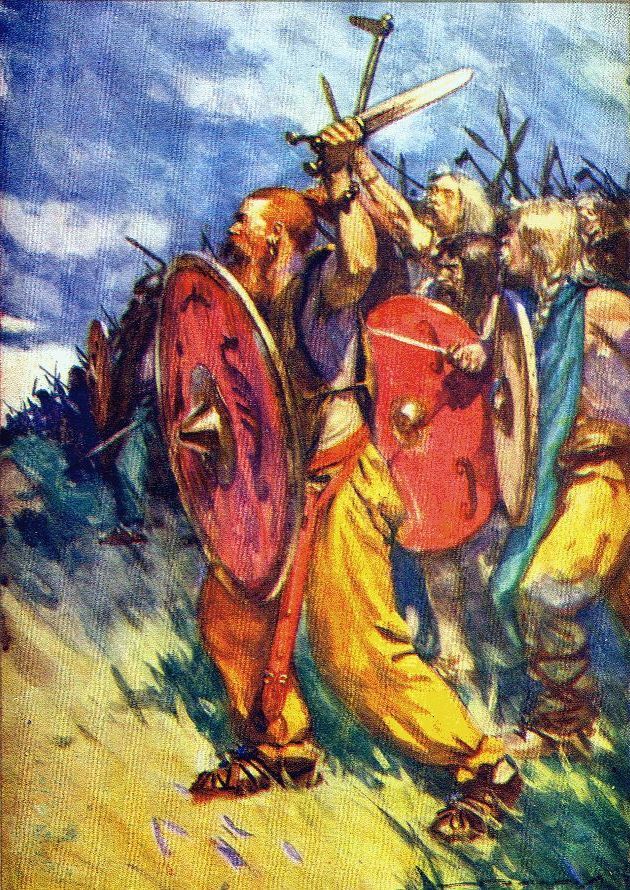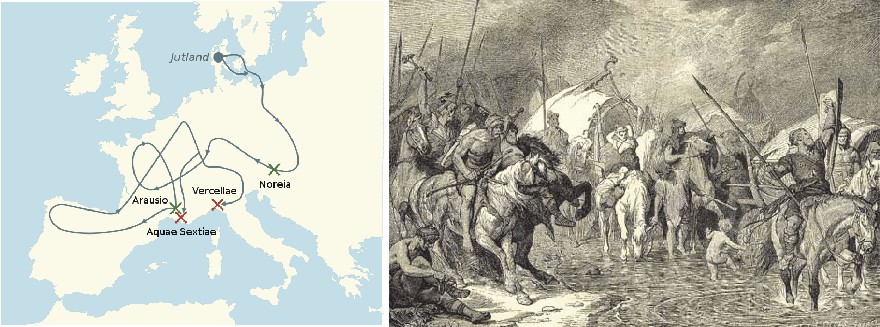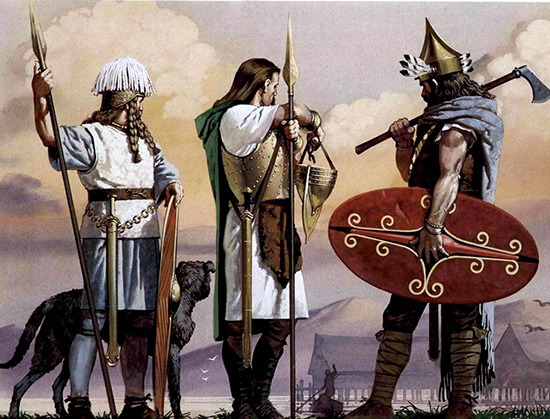 One of Robert E. Howard’s epic historical poems is “An Echo From the Iron Harp.” The poem gained some wide exposure as “The Gold and the Grey” included by Glenn Lord in The Book of Robert E. Howard (Zebra Books) in 1976. According to the Howardworks website, Glenn gave the poem the title as “The Gold and the Grey” as the title for an untitled typescript version. The original title was discovered later and restored in The Ultimate Triumph in 1999.
One of Robert E. Howard’s epic historical poems is “An Echo From the Iron Harp.” The poem gained some wide exposure as “The Gold and the Grey” included by Glenn Lord in The Book of Robert E. Howard (Zebra Books) in 1976. According to the Howardworks website, Glenn gave the poem the title as “The Gold and the Grey” as the title for an untitled typescript version. The original title was discovered later and restored in The Ultimate Triumph in 1999.
Most recently, it was included in the Fedogan & Bremer audio compact disk The Gods of Easter Island with a reading by Donald Sidney-Fryer. Howard had sent the poem under the original title to H. P. Lovecraft in March 1932.
The poem is about the destruction of the ancient northern European tribe, the Cimbri by the Romans at the Battle of Vercellae in 101 B.C. commanded by the Consul Gaius Marius.

Gehard Herm in The Celts states “The Teutones and Cimbri were Germans.” Poul Anderson had a non-fiction piece in that most excellent small press magazine Amra # 3 (1959) entitled “Who Were the Aesir?” mentioned the Cimbri briefly. He also wrote a very good historical novel called The Golden Slave (Avon Books, 1960) about the son of the King of the Cimbri taken prisoner by the Romans. Anderson had the Cimbri as Germanics. It is thought the Cimbri originated in Jutland in what is now Denmark.
The poem has a framing portion that suggests reincarnation.
Here is the interesting thing. Howard has these lines:
“Our German allies bit the dust”
“But to charge in the wild old Celtic way–“
Robert E. Howard viewed the Cimbri as Celts, not Germanics. This is not so far out for various reasons. The chieftains have Celtic names: Boiorix, Lugius, Gaesorix. Henri Hubert stated in 1934 that “All these names Celtic, and they cannot be anything else.” Latham in 1844 said they were a Celtic confederation from Gaul or Switzerland. Rawlinson looked at the German and Celtic origin theories in 1877 and provided six lines of evidence they were Celts.
Peter Berresford Ellis, in The Celtic Empire (1990) came to conclusion:
“The contemporary evidence, however, seems clear enough. The Cimbri and the Teutones spoke Celtic, had Celtic names and used Celtic weapons. The very names of the two tribes were Celtic. They were, then, Celts. And, eventually, they formed alliances with other Celtic tribes, creating a large Celtic army which, once more, nearly brought about the downfall of
Rome.”
Northern Denmark had Celtic fortresses, oppida, as in Europe from the Balkans to the Atlantic Ocean.
The Cimbri venerated cauldrons, the Germans did not. The Cimbri practiced bull-worship, something not practiced by Teutonic tribes.
There are cases of isolated Celtic tribes. The Gotini (“the Stammerers”) were in what is now Slovakia separated from other Celts. Three tribes of Celts invaded Asia Minor to found the territory of Galatia. The Celts in Spain were not contiguous with the Gauls.
The Cimbri were known as raiders, plunderers, and brigands. The Old Irish word cimb means tribute or ransom. The Celts had great names for their tribes. The Volcae means “wolves,” the Ordovici meant “hammer victors,” the Irish name “Connolly” means “valiant.” Contrast this to German tribal names. The Angles took their name because of an angle of a river where they lived. Now think of John Banner as Sgt Schultz: “Ve are the Allemanni, because ve are the All Men.”
The Cimbri leaders did not have German names like Hermann or Gunther.
Quintus Sertorius, an interesting character from the late Roman Republic spoke Gallic. He infiltrated the Cimbri camp as a spy to ascertain their plans. He did not speak German. Sertorius would later lead Celts in Spain as leader of a breakaway region from the Roman Republic.
Howard mentions “the gleam of her golden hair and her eyes like the deep grey sea.” Howard had a fairly consistent idea through his life of two distinct Celtic branches, one, the Gaels:
“They were tall, gaunt men, great drinkers of beer which they brew from hops, I think, gray eyed and sandy haired.” (letter to Tevis Clyde Smith, 1926).
He also has the Britons and Gauls as physically Nordic in appearance.
“After a few hundred years another horde of Celts came from Scandinavia or the wilds of Siberia or some place. They settled in France, raided down into Greece and Spain and sacked Rome. Then they went over the Britain, some of them, and chased the Gaels back into Ireland or up into Scotland or Wales. They were big, muscular fellows, fair eyed and yellow haired, and were called Brythons whence comes Britain.”
In “The Hyborian Age” Howard states:
“The blond Achaians, Gauls and Britons, for intance, were descendents of pure-blooded Aesir.” They were Aesir who took up the culture and language when in contact with the Cimmerians around the shrinking Vilayet/Caspian Sea.
Periodically, you have some Conan or Howard fan who decides to wade into the shallow waters of history and shoe-horn the historical Cimmerians, Cimbri, and Cymry into some sort of unified theory. Cymry is the name the Welsh have for themselves, it is derived from Latin for “fellow countrymen.” The name appeared about the time the British Celts were separated by the Angles and Saxons from Cumbria in north-west Britain, Wales, and Dumnonia/Cornwall.
Leon Nielsen’s “Asgard, Vanaheim, and Cimmeria” from The Cimmerian, Vol 2, No 5 (October 2005) was a more sophisticated but misplaced attempt. Nielsen was an interesting guy, a Dane who served in U.S. Army Special Forces. He tried to make a connection between the Cimbri and the Cimmerians. There is no connection. The name Cimmerian of ancient history name might derive from a Proto-Indo-European word similar to the cimb/brigand/plunderer.
Morgan Holmes had this in response to Nielsen:
“Leon Nielsen’s ‘Asgard, Vanaheim, and Cimmeria’ from the October 2005 issue of The Cimmerian gets a good grade for effort but is highly speculative in nature. We need to get back to Robert E. Howard to get an idea of what he had in mind. First, Hyborian Age Nemedia does not derive from Numidia of Classical times. Howard derived Nemedia from Irish mythology. Nemed and his followers are one of the colonizers of Ireland in Irish myth. The most likely source for Nemed is P. W. Joyce’s A Short History of Gaelic Ireland and The Story of Ancient Irish Civilization. Both books were in Howard’s library wherein Joyce discusses the Nemedians.
Howard’s source for the Cimmerians is most likely from Homer. Here is a passage from Alexander Pope’s translation of The Odyssey that captures the mood perfectly:
There in a lonely land, and gloomy cells,
The dusky nation of Cimmeria dwells;
The sun ne’er views the uncomfortable seats,
When radiant he advances, or retreats:
Unhappy race! whom endless night invades,
Clouds the dull air, and wraps them round in shades.
Denmark does make a part of REH’s Hyborian Age Cimmeria, a small part. Most of Howard’s Cimmeria is now the North Sea. Historical Cimmeria and the area of Jutland that the Cimbri came from were not the same place nor were they the same peoples and Howard knew this. The Cimmerians lived between the Dneister and Don rivers in what is now the Ukraine in early classical times. It is not known if they spoke a Thracian or Iranian language, neither of which are Scandinavian or even Teutonic. The Scythians drove the Cimmerians south at the end of the 8th Century B.C. across the Caucasus Mountains. The Cimmerians proceeded to raid the Assyrians, Lydians, and broke the Phrygians causing King Midas to commit suicide. They were known to the Hebrews as the Gomer and to the Assyrians as the Gimmerai. The Lydians eventually defeated the Cimmerians where that name disappears from history. Cimmerians might have founded the nations of Cappadocia and Pontus in Asia Minor.
The Cimbri emerged about 400 years later from Jutland with no apparent connection to the historical Cimmerians. Howard does make the Gomer/Gimmerai and the Cimbri of the same mix of “Nordic-Cimmerian race” in “The Hyborian Age.” Howard’s Cimmerians, historical Cimmerians, and the Cimbri are not one and the same. Interestingly, Mr. Nielson did not mention Howard’s poem, “The Gold and the Gray” which is about the Cimbri last battle against Marius. Howard views the Cimbri as Celts with the line– “But to charge in the old wild Celtic way- and die, or slash straight through.” The line– “Our German allies bit the dust,” is a reference to the Teutoni, who traveled with the Cimbri. They were the first Germanic tribe the Romans came in contact and therefore source for the word Teuton. Howard’s use of the adjective German before allies is another clue that he viewed the Cimbri as distinct and different in origin from the Teutoni.
Where did Robert E. Howard get the idea the Cimbri were Celts and not Teutons?
He had this to say to Lovecraft in 1932:
“Most authorities consider the Cimbri were Germans, of course, and they probably were, but there’s a possibility that they were Celtic, or of mixed Celtic and German blood, and it gratifies my fancy to protray [sic] them as Celts, anyway.”

Excellent post. Thank you.